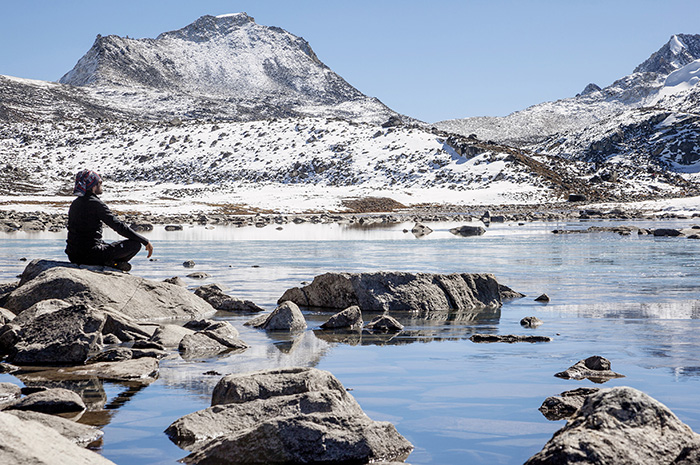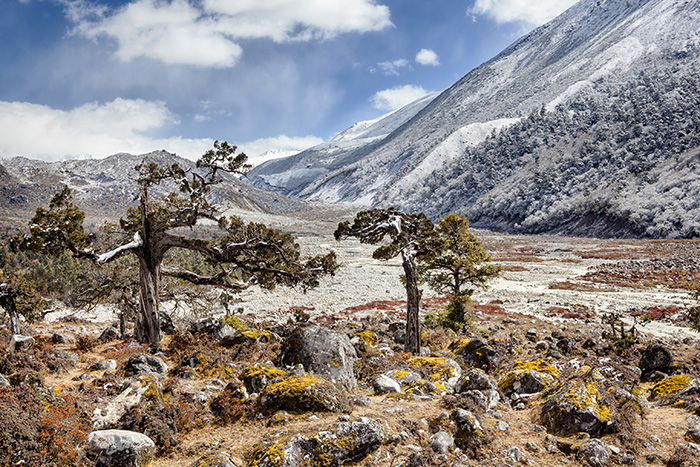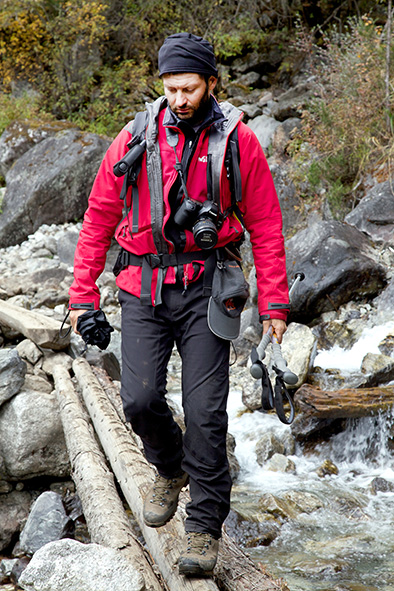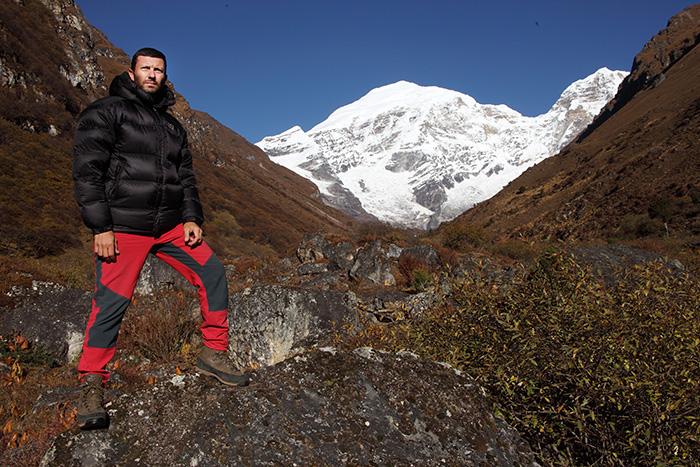Several years ago I was lucky enough to be able to organise and successfully complete an expedition to Bhutan called “Bhutan, The Last Himalayan Kingdom”, which focused on the Snowman Trek. It was a journey of about 350 kilometres on foot, through the most beautiful and far-flung valleys in the Bhutan Himalayas, starting near the city of Paro and finishing in the Bumthang District town of Jakar.
I’ve always been fascinated by this small country; one of the highest places in the world, which has maintained its cultural and religious traditions intact and despite the borders with China to the north and India to the south, has managed to maintain its own identity.
After many experiences in the Himalayas, I chose to do the Snowman Trek with a group of friends. I was driven by curiosity to undertake a journey that is considered by many to be one of the most challenging and beautiful hikes in the world. Altitude, distance, snow (which is almost always present in the high altitude sections) and unpredictable weather conditions make for a challenging combination of elements; in fact, crossing the last Himalayan kingdom is a double challenge – with oneself and with the mountain environment – which makes this an attractive adventure and a very exciting experience. I prepared myself for a long time for this expedition, trudging back and forth in the Apuan Alps and the Dolomites, in order to achieve a good level of psychological preparation and physical fitness. I trained hard, convinced that these efforts would help me at high altitude.

I like to think that the more you suffer during training at home, the less you suffer during the expedition.
In addition to good physical preparation, you have to have a lot of determination; the psychological aspect is important in the mountains. It takes good mental attitude – positive and rational, to deal with the unexpected changes that nature throws in your path, and making the right choices at the right time. An expedition like this one has to be planned right down to the smallest details, from technical equipment to logistics. Take nothing for granted, remember that you will pay the price of every omission when you are on the ground. In my experience to date, I can say that the success of any group expedition is due to the capabilities of its individual members, good team spirit and also a bit of luck.
The Snowman Trek lasted 25 days – a total of 343km of paths between valleys and high altitude mountain terrain. We trekked through 14 mountain passes, the highest of which was at 5,385 metres above sea level, while the total change in altitude was 17,220 metres. I will try to briefly describe this fascinating adventure, which all mountain lovers should have on their list of “things to do before I die”.
Arriving in Paro by plane is already a mini-adventure, as the city is nestled in a deep valley and the aircraft does several breathtaking manoeuvres when approaching the runway for landing. Near Paro is Thimphu, with its uniquely beautiful dzong (Buddhist monasteries), where I witnessed a major religious festival with dancers in traditional costumes and ancient ritual masks. After a few days of walking through hills and rivers, the mountains became visible in the distance and we began to climb. Entering the Jigme Dorji National Park, the rhododendrons and oaks that dominate the lower valleys give way to conifers covered with long lichens, which make the landscape quite surreal when you look up.
Days go by; the coniferous forests thin out and then, finally, we are at the foot of the mountains! Jomolhari is there before me – an impressive 7,314 metres of rock and ice with a perennially snow-capped summit. At its feet, the mountain pass lies next to an old fortress; this ancient construction, now in ruins, was built to defend against Tibetan attacks from the north.

After a good acclimatisation period around 4,500 metres, we started climbing steep trails and passes that range between 4,800 and 5,000 metres. Up and down, important positive and negative altitude changes of several hundred metres, sometimes as much as 1000 metres.In front of me a sea of mountains unfolds, with unclimbed peaks over 7000 metres high.
We pass through villages, meeting the unique people who live following the natural rhythms of the seasons, their faces scarred by the cold and wind. Jangothang, Lingshi, one village after another, just like the mountain passes that open onto snow leopard territory; the snow leopards still manage to live undisturbed here.
Weeks go by and fatigue sets in, the nights are cold, temperatures drop to -10°C, but luckily the weather is good. It does not snow and the mountain passes are open. We are now in the region of Lunana, where the barley harvest season has just ended – the fundamental livelihood of the inhabitants of this unique land. Even now, when I close my eyes, I can still see the crystal clear sky above the hanging glaciers of Teri Gang at 7,300 metres, with a large glacial moraine below; in the distance, two other huge glaciers create coloured lakes, and the melting ice flows into a river that runs underneath our path. This is a majestic landscape, and a challenging one. The exposed paths require our full attention, and at this point-of-no-return, every single step has to be made carefully. A physical problem or any type of accident would be big trouble. We are several days’ away from the nearest village, and an evacuation from these remote places would be an enormous undertaking. Every night, the base camps are higher and higher. At 5,000 metres the sky is clear and it is bitterly cold, but we are rewarded with a star-studded ceiling that can be compared to no other. The high-altitude lakes unfold one after the other, some with dark waters, some with clear waters and colours that reflect the blue sky. These images remain indelibly in the memory, and satisfy the most demanding explorer.
The weather situation changes and snow begins to fall. Our tracks are soon covered up, and this is not a good sign; after weeks of walking at high altitude we didn’t need this, but it is part of the game and I am aware of it. We approach the final and highest pass – Ghopu-La at 5,486 metres, then there are other lower passes and finally the long descent that will lead me to the end of my journey, but the end is still far away.

It stops snowing and the scenery is even more surreal with more unclimbed peaks around 7,000 metres. Occasionally we come across some grazing yaks, and we also meet a caravan that is climbing our path with a load of wool and hay for the cold Himalayan winter; men run around shouting and whistling at the yaks to get them to climb, while we can only stop and watch these strange, imposing animals that fearlessly climb these mountains. I ask one of our porters for the name of the mountain in front of me that has attracted my attention because of its blade-like form. The man looks at me in surprise and says that it is called simply “mountain”, it is a mountain and mountain is its name. I am quite embarrassed by his answer; in fact it is the obvious truth. It is our cultural heritage that drives us to give a name to every mountain we see; in the end, mountains are mountains.
We are still descending, and begin to see the valleys below, carved out by rivers that we had seen as mountain streams several days before, and forests which we know to mean that in a few days we will be on the last leg of the adventure. It begins to snow again, but this time we are at lower altitudes and the higher temperature here favours this type of snowfall. It snows heavily; if this had happened a week ago it would have been a real problem. We carry on in the whiteness, awaking every morning in base camps buried under at least ten centimetres of snow. But our morale is high, we are determined, and now we are all quite sure that we will reach our goal.
The path rises again, there are more mountain passes between 3,500 and 4,000 metres and lakes and villages that are totally in tune with the environment; there is nothing out of place, traditional clothing has not been completely abandoned and traditions are still taken into account. We passed the last glaciers which continue to melt because of global warming and we descend again, but now we are walking through slush and mud; I am soaking wet from head to foot and my specialist clothing is no longer holding out against the elements. High altitude terrain may bring higher risks, but I vastly prefer it to this cold mud all the way up to my knees.

Following the winding trail through the woods and meadows where yaks graze, we finally reached Dur Tsachu which is known for its thermal springs. After 22 days of walking, during which washing was the last thing you wanted to do, it’s so nice to be able to soak in tanks of hot water used by locals to cure a wide range of varied pathologies. After the last of the 14 mountain passes – Juele-La at 4,710 metres, we are in the Bumthang District again. We hear the voices of distant shepherds more frequently; for weeks we have not seen a living soul, and now we slowly begin to digest the fact that our adventure is about to end.
We have descended to 2,500 metres when it starts to snow heavily again. The Snowman Trek is not about to let us go that easily, we are reminded that it is not over yet, and as we continue to descend, the snow turns to rain. But I’m not giving up, we arrive back and now it really is over. In the distance I can see the dirt road and the off-road vehicles that are waiting for us.
A rush of contrasting emotions overtakes me; the intense joy of having made it, and the melancholic sadness that the adventure is over. This sensation cannot be described properly, but everyone should experience it at least once in their lifetime. I returned home with indelible memories of a unique place, inhabited by a proud people, able to live with tradition alongside globalisation, in harmony and symbiosis with nature. Bhutan, the last Himalayan kingdom.
Words + Photos By: Massimo Ziino

